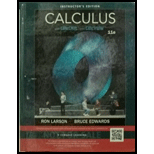
Domain and Continuity In Exercises 1-4, (a) find the domain of r, and (b) determine the interval(s) on which the function is continuous.
(a)
To calculate: The domain of the function
Answer to Problem 1RE
Solution:
The domain is
Explanation of Solution
Given:
The vector-valued function is
Calculation:
Consider the function:
The x-coordinate of the function cannot be zero. Thus,
Where n is integer.
Thus, the required domain is
(b)
To calculate: The interval on which the function
Answer to Problem 1RE
Solution:
The function is continuous for all
Explanation of Solution
Given:
The function
Calculation:
Consider the function:
Evaluate the continuity of the vector valued function by evaluating the continuity of the component functions and then taking the intersection of the two sets.
The component functions of the vector valued function are:
Both the functions g and h are continuous for all real values of t.
However, the function f is continuous for
Where n is an integer.
Therefore, the function is continuous for
Want to see more full solutions like this?
Chapter 12 Solutions
Calculus (MindTap Course List)
- Suppose that a particle moves along a straight line with velocity v (t) = 62t, where 0 < t <3 (v(t) in meters per second, t in seconds). Find the displacement d (t) at time t and the displacement up to t = 3. d(t) ds = ["v (s) da = { The displacement up to t = 3 is d(3)- meters.arrow_forwardLet f (x) = x², a 3, and b = = 4. Answer exactly. a. Find the average value fave of f between a and b. fave b. Find a point c where f (c) = fave. Enter only one of the possible values for c. c=arrow_forwardplease do Q3arrow_forward
- Use the properties of logarithms, given that In(2) = 0.6931 and In(3) = 1.0986, to approximate the logarithm. Use a calculator to confirm your approximations. (Round your answers to four decimal places.) (a) In(0.75) (b) In(24) (c) In(18) 1 (d) In ≈ 2 72arrow_forwardFind the indefinite integral. (Remember the constant of integration.) √tan(8x) tan(8x) sec²(8x) dxarrow_forwardFind the indefinite integral by making a change of variables. (Remember the constant of integration.) √(x+4) 4)√6-x dxarrow_forward
- a -> f(x) = f(x) = [x] show that whether f is continuous function or not(by using theorem) Muslim_mathsarrow_forwardUse Green's Theorem to evaluate F. dr, where F = (√+4y, 2x + √√) and C consists of the arc of the curve y = 4x - x² from (0,0) to (4,0) and the line segment from (4,0) to (0,0).arrow_forwardEvaluate F. dr where F(x, y, z) = (2yz cos(xyz), 2xzcos(xyz), 2xy cos(xyz)) and C is the line π 1 1 segment starting at the point (8, ' and ending at the point (3, 2 3'6arrow_forward
- Algebra & Trigonometry with Analytic GeometryAlgebraISBN:9781133382119Author:SwokowskiPublisher:Cengage
